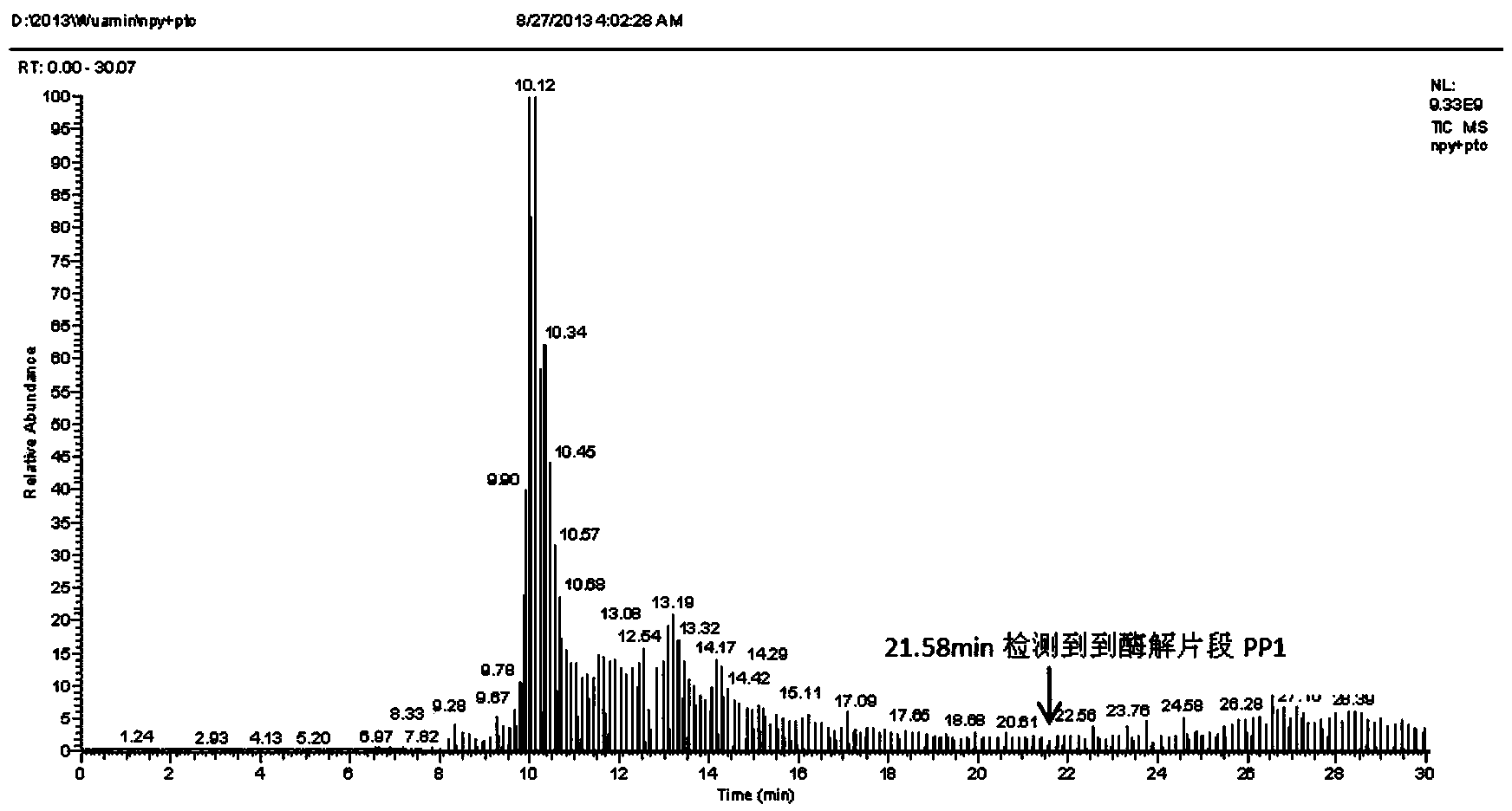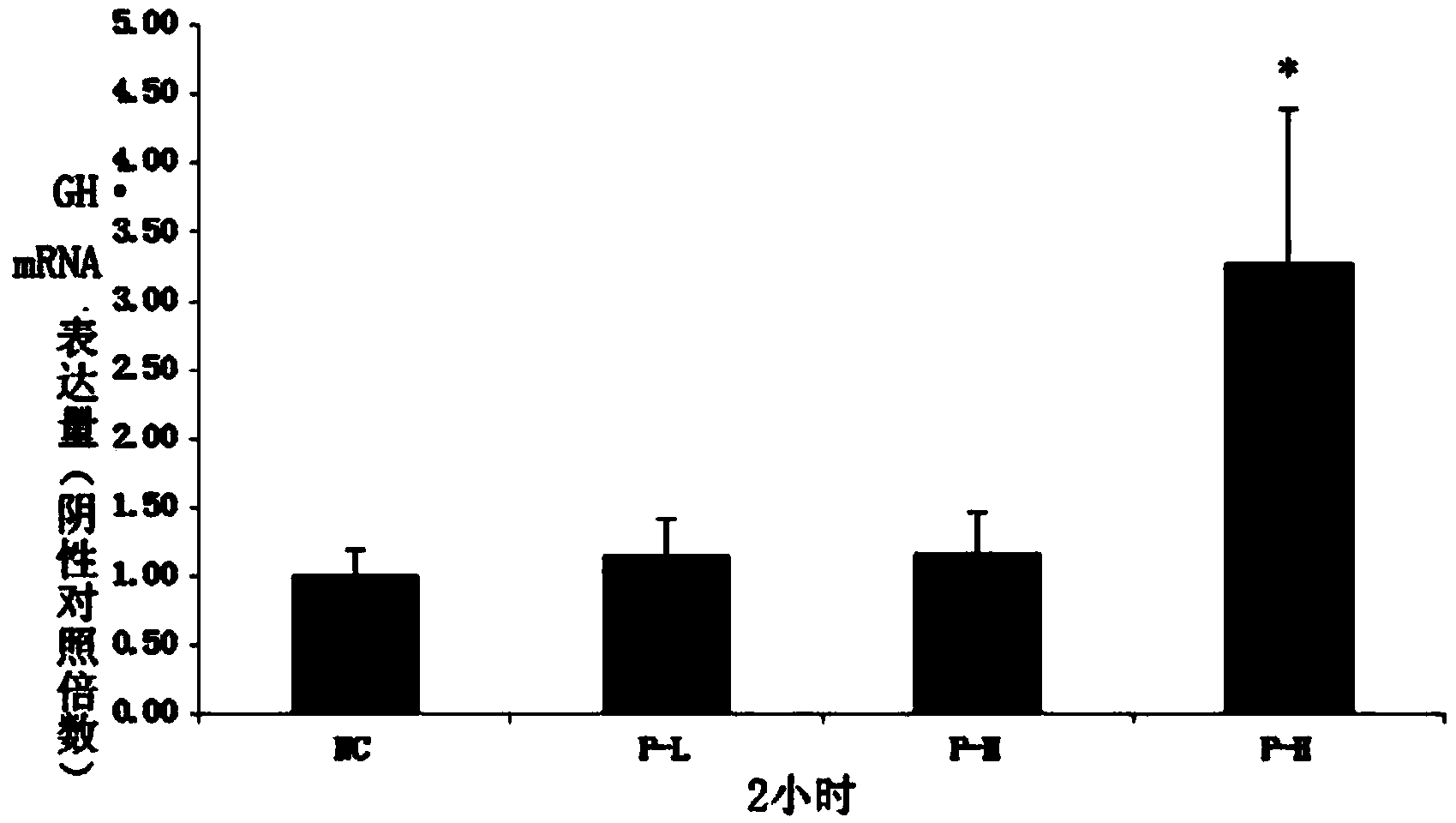Polypeptide PP1 capable of promoting expression of growth hormone of tilapia mossambica and application thereof
A tilapia and growth-promoting agent technology, applied in the field of polypeptide function research, can solve problems such as reduced food intake and weight loss, and achieve the effect of promoting growth and good application prospects
- Summary
- Abstract
- Description
- Claims
- Application Information
AI Technical Summary
Problems solved by technology
Method used
Image
Examples
Embodiment 1
[0023] Example 1: Analysis of Tilapia digestive tract enzymatic hydrolysis products
[0024] The tilapia with uniform body weight of 50±2 grams were selected to be fed commercial compound feed in groups, and the adaptation period was 7 days. They were fed at 9:00 every day, and samples were extracted on the 4th day. After feeding, it was divided into 6 periods of 1.0, 1.5, 3.0, 6.0, 9.0, 12.0, and 24.0 hours, with two fish in each period, and all samples were mixed with the amount of the two fish. Blood was drawn from the tail vein of the fish with a syringe at each time period, and all the blood was extracted and injected into 3.8% (w / v) trisodium citrate dissolved in PBS at a ratio of 1 / 10. Then the tilapia was dissected, and the gastrointestinal tract was taken and washed with normal saline. The tilapia stomach was divided into cardia, pyloric caeca and pylorus, and the intestine was divided into duodenum (pyloric part of stomach to intestinal spiral part), Foregut (the ...
Embodiment 2
[0026] Embodiment 2: Tilapia enzymolysis fragment PP1 Functional studies of - intraperitoneally injected juvenile tilapia
[0027] The polypeptide PP1 was prepared by chemical synthesis according to the sequence obtained by mass spectrometry detection. Dissolve PP1 and positive control protein NPY (neuropeptide Y) in PBS buffer, and inject intraperitoneally into juvenile tilapia. The experiment was divided into negative control group (PBS buffer), PP1 and positive control protein high-dose group (0.24nmol / gbw), PP1 and positive control protein medium-dose group (0.12nmol / gbw) and PP1 and positive control protein low-dose group (0.024nmol / gbw), 10 fish in each group. The fish were anesthetized with eugenol at 2 hours and 6 hours after the injection, and the pituitary tissues were taken out in liquid nitrogen, and then transferred to a -80°C refrigerator for storage until use. RNA was extracted according to the instruction manual of Trizol reagent from Invitrogen Company, ...
Embodiment 3
[0028] Example 3: Polypeptides PP1 Functional studies of - repeated intraperitoneal injections of juvenile tilapia
[0029] According to the results of the first intraperitoneal injection, PP1 and the positive control protein can promote the expression of GH mRNA to a greater extent 2 hours after injection, so the injection experiment was repeated, focusing on the effect of sampling 2 hours after injection on the expression of GH mRNA. The experiments were negative control group, PP1 and positive control protein high dose group (0.24nmol / gbw), PP1 and positive control protein medium dose group (0.12nmol / gbw) and PP1 and positive control protein low dose group (0.024nmol / gbw ), 15 fish in each group. Two hours after the injection, the fish were anesthetized with eugenol, and the pituitary tissue was taken out in liquid nitrogen, and then transferred to a -80°C refrigerator for storage until use. RNA was extracted according to the instruction manual of Trizol reagent from I...
PUM
 Login to View More
Login to View More Abstract
Description
Claims
Application Information
 Login to View More
Login to View More - R&D
- Intellectual Property
- Life Sciences
- Materials
- Tech Scout
- Unparalleled Data Quality
- Higher Quality Content
- 60% Fewer Hallucinations
Browse by: Latest US Patents, China's latest patents, Technical Efficacy Thesaurus, Application Domain, Technology Topic, Popular Technical Reports.
© 2025 PatSnap. All rights reserved.Legal|Privacy policy|Modern Slavery Act Transparency Statement|Sitemap|About US| Contact US: help@patsnap.com



